The below Vanilla article has vast information about Vanilla industry, history, Vanilla production process , growing vanilla, hand pollination, curing process and Vanilla beans Storing
General information about Vanilla : Edible Orchid, Expensive Spice, Vanilla History, Vanilla as a oldest Aphrodisiac
Benefits of Vanilla beans : Health benefits and other uses of Vanilla beans products
About Vanilla plant : Botany of Vanilla, features of all the parts of the Vanilla plant, Vanilla cultivars with their aroma, flavor and growing areas
Vanilla Cultivation : Using greenhouses for growing Vanilla, Vanilla Farming, land selection, land preparation, best climate, soil conditions, Propagation, Cuttings for planting, shading vanilla plants
Vanilla Pests and Diseases management : Vanilla Fungal Diseases, Symptoms and controls, Viral diseases, Management of Vanilla diseases
Flowering and Pollination : Vanilla Hand pollination, Best time and process of vanilla pollination, Development Process of Vanilla fruits
Green Vanilla Beans Harvesting : Best time to harvest, How to Harvest green vanilla beans, harvesting indicators / how to identify best beans for harvesting
Process of Vanilla Curing : Information about Vanilla curing stages (Killing, Sweating and conditioning), Steps in Vanilla curing in Madagascar, Mexico, Tahiti, Puerto Rico. Vanilla Oven-Wilting, Storing Cured vanilla
Vanillin in Vanilla
Acknowledgement & References
General information about Vanilla
Do you eat orchids?
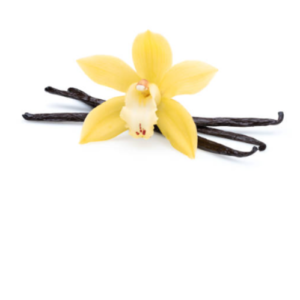
Apparently, yes, it happens a lot more frequently than you realize.
Because vanilla, the queen of spices, is a tropical orchid product,
One of the most fascinating plants on the planet is the vanilla orchid (Vanilla planifolia).
Vanilla is the only edible species among the over 35,000 orchid species that make up the world’s second-largest botanical family.
Second most costly spice in the World

We equate the term “vanilla” with dull, uninteresting, and banal, even though true vanilla is a sought-after commodity, generally the second most expensive spice in the world.
However, vanilla vine is a unique plant that demands specific attention, particularly during pollination, when each blossom must be hand pollinated.
The vanilla vine, which is native to Mexico and Central America, is an excellent addition to any tropical garden.
The world’s most popular spice
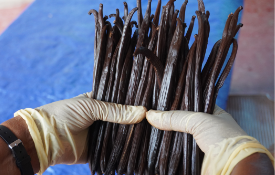
Since it was first introduced to the world in the 16th century, vanilla has maintained the coveted distinction of being the world’s most popular spice. It is beautifully scented, filled with flavor, and adaptable enough to be used for just about every confection
Vanilla beans History
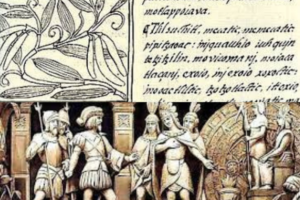
Vanilla planifolia is a Mexican native.
Vanilla planifolia is native to Mexico and may have been utilized as a flavoring by the Totonac culture up to 1000 years ago. Because vines were a gift from the gods, the Tontonacas continued to cultivate them with almost religious zeal. It is common for people to have vines growing around their homes. Every day, these are watered as though they were the Tontonacas’ most prized asset. The vanilla beans were sent to the Aztec Emperor as a gift.
Europeans used vanilla with cocoa beans.
While searching for treasures in the New World, Herman Cortez, a Spanish conquistador, met Emperor Montezuma in 1518. He noted that the Emperor drank Chocolatl, a regal beverage made of vanilla-scented chocolate. Cortez was so taken by the regal drink that when he returned he brought sacks of cocoa and vanilla along with treasure from Montezuma’s destroyed empire. Within a half-century, chocolate with a vanilla flavour was being produced in Spanish facilities. For a long time, vanilla was solely used in conjunction with cocoa beans by Europeans.
Started using vanilla flavoring on its own.
By 1602, vanilla was being utilized as a stand-alone flavor, according to Queen Elizabeth’s apothecary, Hugh Morgan. Vanilla’s popularity increased after that, surpassing that of chocolate and any other flavor known before or since. For more than 300 years after Cortez discovered it, vanilla was exclusively produced in Mexico.
The bee helps to pollinate vanilla blossoms.
Vanilla plants were grown in a variety of nations, but the orchids never produced fruit. It wasn’t until 1836 that a Belgian called Charles Morren discovered that ordinary insects couldn’t pollinate the orchid that the enigma was solved. He discovered that the Melipone, a little bee found exclusively in Mexico’s vanilla areas, is especially able to pollinate the blossoms. Because the bee could not live outside of Mexico, Morren devised a way of manually fertilizing vanilla blooms.
Hand Pollination starts with
The Vanilla bean was sent to Reunion, a little island off the coast of Madagascar, by the French. Edmond Albius, a former slave, invented a rapid and easy method of hand-pollination that is being employed today.
The spread of vanilla to other countries
The French began cultivating vanilla on several of their islands in the Indian Ocean, the East and West Indies, and Oceania soon after its discovery; the Dutch planted it in Indonesia; and the British carried it to southern India.
The push for extensive cultivation in the Indian Ocean region came after the invention of hand pollination. Vanilla cultivation in Sri Lanka, Papua New Guinea, and other recent expansions in South Asian countries. Madagascar, Cormoro, and Reunion islands account for 75% of current output. Scientists are striving to enhance the vanilla flavor and grow plants using tissue culture.
Vanilla is the world’s oldest aphrodisiac.
Vanilla is a lovely, scented aphrodisiac with magical properties in both physical energy and love. This has all the qualities of a contemporary aphrodisiac, such as being seductive, sensuous, and tempting. Vanilla is one of nature’s most complex and uncommon plants, whether you choose to eat it or smell it.
According to legend, Xanat, the youthful daughter of the Mexican fertility goddess, fell in love with a Totonac adolescent. She changed herself into a plant to bring pleasure and happiness because she was unable to marry him due to her heavenly nature. She took on the form of the vanilla orchid in order to remain forever connected to her human love and his people. The Vanilla Festival, which takes place at the conclusion of the harvest, is still celebrated by the locals with dances and feasts.
The health and other advantages of vanilla beans
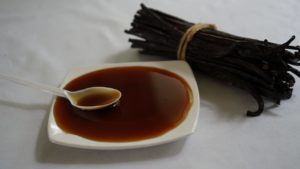
Vanilla extract and other vanilla bean products such as vanilla paste and powder are popular flavoring agents. Further research shows that particular chemicals in vanilla extract and beans may have antioxidant, anti-inflammatory, and neuroprotective qualities.
However, no studies have been conducted so far to determine if these advantages apply to individuals who consume pure vanilla in regular doses. As a result, it’s unknown if vanilla goods will have a substantial impact on your health.
Vanilla extract, paste, powder, and beans are widely used for many recipes to give real vanilla flavor.
Pure vanilla beans, vanilla bean powder, and vanilla paste offer a distinctive and tasty touch to a variety of dishes.
The following are five quick ways to use vanilla products.
- Use a pinch of vanilla bean powder or extract for coffee.
- A dash of powder to smoothies
- Use vanilla extract or A-grade beans for baking cakes or cookies.
- Add vanilla paste or powder for waffle and pancake mixes.
- For ice cream recipes, use pure vanilla beans grade A.
4 health benefits of vanillin
It has anti-inflammatory properties. Animal and test-tube tests, vanillin has been found to have anti-inflammatory properties.
Antioxidant. Vanillin is known to have strong antioxidant capabilities, albeit they have only been tested in test tubes and on animals.
Neuroprotective According to several mouse studies, vanillin may boost brain function and protect against neurodegenerative illness.
Helps to reduce body sugar level
Anti-inflammatory properties of vanilla
Although inflammation is a natural aspect of the immune response, persistent inflammation has been linked to a number of health issues, including an increased risk of chronic illness.
Eating a diet rich in anti-inflammatory foods and beverages may lower inflammatory indicators in your body and enhance general health.
Vanillin, a chemical found in vanilla products, has been demonstrated to have potent anti-inflammatory properties.
In the 2018 research, mice were fed a high-fat diet to produce obesity, and oral vanillin supplements were found to lower inflammatory indicators including interleukin-6 (IL-6) and tumour necrosis factor-alpha (TNF-) in both blood and liver tissue.
Another 2017 study in mice discovered that oral therapy with varied dosages of vanillin decreased psoriasis-related skin inflammation.
In addition, vanillin has also been reported to protect against inflammation-related cell damage in other rodent and test-tube investigations.
In humans, however, there is no evidence that ingesting vanilla extract or beans decreases inflammatory indicators or protects cells from inflammation-related damage.
The chemicals employed in these investigations were condensed from vanilla goods, not pure vanilla products.
Antioxidant properties of Vanilla Beans
Some of the molecules contained in vanilla extract and beans have antioxidant properties, which means they can help protect cells from harm.
For example, the antioxidant capacity of two of vanilla’s phenolic plant components, vanillin and vanillic acid, has been studied.
A 2020 test-tube investigation discovered that vanillin and vanillic acid both protected brain cells from oxidative damage. Vanillin was discovered to be the more potent of the two.
In a study of aged rats, vanillin was found to protect against liver damage and age-related oxidative damage.
Another rat research study published in 2011 found that pretreatment with vanillin protected against induced liver damage.
While it is obvious that vanilla extract and vanilla beans contain antioxidant-protective chemicals, it is still uncertain if taking regular doses of vanilla will provide any antioxidant advantages to people.
Vanilla beans for brain health
According to some studies, some chemicals contained in vanilla, such as vanillin and vanillic acid, may benefit brain function. They may also have neuroprotective qualities, which means they might protect your neurological system.
2021 research, for example, looked at the neuroprotective properties of vanillic acid on mice that had been injected with a neurotoxin—a drug that may impair the neurological system.
It was discovered that vanillic acid injections reduced nerve cell inflammation, decreased indicators associated with Alzheimer’s disease, and reduced memory impairment induced by the neurotoxin.
Vanillin has also been shown in studies to be a potential neuroprotective agent.
However, there is no evidence that consuming a lot of vanilla extract or vanilla bean improves brain function or protects against cognitive decline in people.
Vanilla helps reduce added sugar intake.
Using vanilla extract or vanilla bean powder in dishes and beverages may help you cut back on added sugar.
According to a 2020 research study of 129 young individuals, adding vanilla scent to sugary drinks increased their perceived sweetness.
2021 research also found that flavoring a low-sugar yoghurt with vanilla had no effect on its perceived sweetness.
A 2020 study of 112 youngsters found that adding vanilla to milk-based sweets boosted the overall liking of reduced-sugar alternatives in more than 80% of participants.
This implies that including vanilla in sweets may lessen the need for extra sugar.
About Vanilla plant
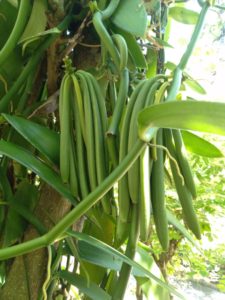
Taxonomy
The most significant and well-studied variation is Vanilla planifolia (also known as Vanilla fragrans Salisb. Ames). Purseglove et al. (1981) reported over 110 vanilla species found throughout the world’s tropical areas. Vanilla planifolia is a member of the orchid family, which includes over 700 genera and over 20 000 species. However, vanilla is the only edible fruit that includes taste and fragrance components that are significant (Ranadive, 1994; Rain, 1996). Mabberley et al. (1997) described vanilla taxonomy, which is presented below.
Taxonomic classification of Vanilla
Kingdom Type Class Order Family Tribe Genre Species | Vegetal Fanerogamae Monocotyledonae Microspermae Orchidaceae Vanilleae Blume Vanilla Swartz Vanilla planifolia Andrews Vanilla pompona Schiede Vanilla tahitense J.W Moore |
(Mabberley et al., 1997)
Botanical description
Depending on the kind of soil, there are three primary systems for extensive vanilla farming. Two techniques make use of native trees known as “Acahuales” or “native forest trees,” while the third system is employed in places where there are no trees. The objective of each system is to achieve 2 Tones of green vanilla beans per hectare, fully productive propagation material (cutting), and to extend the productive life of the vanilla orchard to five years of full output.
Features of Vanilla plants
Structure of the plant
It’s a tough climbing vine with a single leathery leaf approximately 12 cm long at each node, as well as roots that cling to its host tree or trellis in culture. The vine may grow up to 20 mm in diameter. Vanilla planifolia is available in two varieties: plain and variegated. The plant normally does not blossom until it is at least 3 meters tall, and it can grow to be as large as 20 meters. Vanilla fragrance, often known as vanilla planifolia, is an herbaceous perennial vine that climbs to a height of 10–15 meters via adventitious roots up trees or other supports. It is trained to a height that allows for hand pollination and harvesting in cultivation.
Root system
Long, white, adventitious roots with a diameter of about 2 mm are generated singly opposite the leaves and firmly cling to the support over which the plant climbs. In the humus or mulch layer, the roots at the base ramify. It has endotrophic mycorrhiza. The velamen, or outer parchment sheath, is underdeveloped.
Features of Vanilla Stems
The succulent, flexuous, and brittle stems are long, cylindrical, monopodial, and simple or branching. They are dark green and photosynthetic, contain stomata, and have a diameter of 1–2 cm. Internodes range in length from 5–15 cm.
Leaves

The subsessile leaves are huge, flat, succulent, and alternating, oblong-elliptic to lanceolate, and 8–25 cm long and 2–8 cm wide. The base is rounded and the tip is sharp and acuminate. Numerous, parallel, and obscure veins run throughout the body. The petiole is canalised above and is short and stout.
Inflorescence
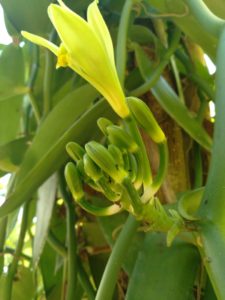
The robust inflorescences are axillary, simple, and rarely branch. They are normally found at the top of the vine and are 5–8 cm long, with up to 20–30 blooms blooming from the base upwards, with only 1–3 blossoms opening at a time and each flower lasting one day. The rachis is robust and typically curved, with a diameter of 4–10 mm. The bracts are firm, concave, and persistent, measuring 5–15 mm in length and 7 mm in width at the base.
Flower Characteristics

The blooms are little lily-like (or slim cattleya-like) greenish-yellow flowers that form in axillary racemes and are around 40 x 60 mm in size.
A raceme typically has approximately 20 blooms, although many more have been seen.
In most cases, just one flower in a raceme blooms every day, with the raceme’s blooming phase lasting an average of 24 days.
Each flower contains three sepals and three petals, one of which is enlarged and modified to produce the trumpet-like lip, as well as a central column made up of the combined stamen and pistil.
The anther is at the top of the column and hangs over the stigma, but they are separated by a flap called the rostellum.
Vanilla cultivars
Characteristics of the world’s major vanilla varieties
Bourbon vanilla, also known as Bourbon-Madagascar vanilla, is a type of vanilla that comes from Madagascar.
Cultivation zones: Indian Ocean islands such as Madagascar, the Comoros, and Réunion, historically known as the Île Bourbon. It’s also used to describe the particular vanilla taste generated by V. planifolia, a tropical plant that’s cultivated effectively in Sri Lanka and India.
Flavors: typical, with smooth, creamy finish notes and a full aftertaste of dried fruits reminiscent of cinnamon essence.
Aroma: Pleasant and balanced, and it has the most comprehensive profile of any vanilla extract.
According to a genetic study, this species is most likely a hybrid of V. planifolia and V. odorata.
Tahiti and Moorea are the only islands with cultivation zones.
Flavors: A swift initial flavor release that is rather sweet, with oily undertones that are somewhat mild.
Pink pompona:
Cultivation zones: The Caribbean, Central America, and South America are all home to V. pompona.
Flavors: Its main area of application is pharmaceutics and perfumes (Claridades agropecuarias, 2002).
Growing Vanilla in Greenhouses
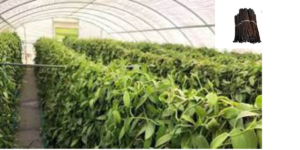
The goal of glasshouse vanilla growing is to reproduce the conditions found beneath the rainforest canopy. To accomplish so, you must manage the climatic parameters such as temperature, humidity, etc. with equipment such as fogging, shade screens, and so on.
Furthermore, the greenhouse protects the vanilla from climate threats such as excess water, which might lead to disease outbreaks. Furthermore, the glasshouse will allow for year-round human interaction, allowing for regular monitoring of the orchid’s progress.
The Benefits of Growing Vanilla in a Greenhouse
Improved climate management inside the greenhouse (growing area) to more precisely monitor and adjust relative humidity (RH percent), temperature, and light transmission.
An effective ventilation system to drain humidity and recycle air as needed.
Higher production density within the glasshouse (20 plants/m2) due to air circulation and glasshouse ergonomics;
Higher production density within the glasshouse (20 plants/m2) because of higher air circulation and glasshouse ergonomics;
Higher production density within the glasshouse (20 plants/m2) because of good air circulation and glasshouse ergonomics;
Maximum growth of up to 25 cm per week and monthly flowering.
Improved pest and disease protection and integrated pest control in the growing area;
A Guide for Vanilla Cultivation
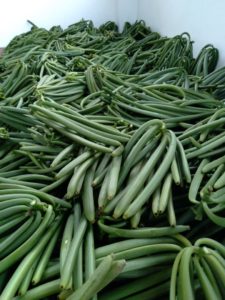
- V. planifolia grows by climbing on trees in damp tropical lowland woods from sea level to 600 meters in the wild.
- It grows best in hot, humid, insular climates with frequent, but not excessive, rain.
- It is best to avoid areas with a protracted dry season.
Cultural practices
The following are the environmental requirements of the crop:
Vanilla production necessitates temperatures ranging from 21 to 32 °C, annual precipitation of 1500 mm or more, an 80 percent relative humidity, and elevations ranging from 0 to 600 m above sea level.
Soil: Vanilla grows best on gently sloping terrain with light friable soil, enough but not excessive drainage, and a thick surface layer of humus or mulch to let the roots spread. Excessive water consumption is dangerous.
Partial shade is required, which is generally given by the shrubs or small trees that the vines are growing on.
Soil with a PH range of 6 to 7 is preferred.
Land Orientation: Where slopes prevail, it is preferable to choose production locations with an eastward orientation that are shaded by sunlight in the mornings.
This is done to reduce soil moisture loss and over drying of the plant (leaf burn) and beans in the afternoon sun.
Land Preparation and Planting of Climbing Trees (Tutors)
Preparations are done based on the height of the native trees in the vanilla-producing location. You need to decide the number of tutors based on the land used for the vanilla cultivation.
For forest type land, if trees higher than 10 meters and broader than 50 centimeters in diameter prevail
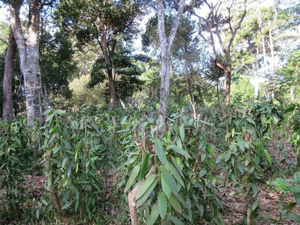
Weeds must be controlled. Branches less than 4 m from the ground should be cut down to improve shadow distribution and ventilation by 50%.Cut plant debris is often shredded and used as mulch as an organic matter source. When this is completed, tutors (climbing trees) are planted to support the vanilla plants.
5000 tutors are planted per hectare, in rows with a gap of 1 m between tutors and rows of two. The system consists of two single rows with tutors spaced one meter apart. There is a row of tutors, a 1 m space, another row of tutors, a 2 m space, one row of tutors, a 1 m space, and so on. Trees that do not meet the patterns of the rows for tutors must be removed from tree land (forest and acahual) as long as the shadow ratio is not substantially altered.
Secondary vegetation-type land: Bushes and trees smaller than 10 m and widths of less than 20 cm predominate.
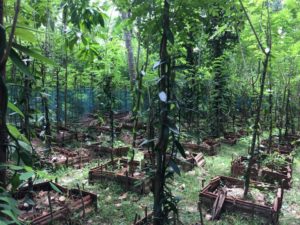
Weeds must be removed, and mulch is made from dried branches. Bushes that will give shade and support are chosen; these bushes should have a single stem, no branches on the ground, and a height of 1.7 m with shadows that extend beyond 2 m. Trees and shrubs taller than 2 meters should only be utilized as shade producers.
It is advised that 6,600 tutors be planted in double rows per acre.
Deforested Land: No trees or bushes
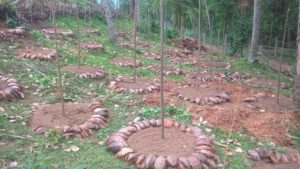
There are 10,000 tutors per hectare established and distributed in a 1 m by 1 m frame.
Characteristics of Vanilla Climbing Trees/Tutors
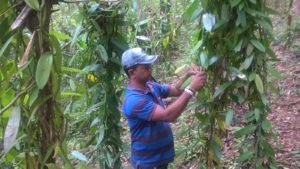
Vanilla vines require some type of support to climb, as well as mild shade; both full sun and thick shade are harmful. The trees should be
fast-growing, producing a light, chequered shade;
We have enough low branches to get to the vanilla easily.
sturdy enough to sustain the vines in high winds,
It is readily trimmed when needed.
It is advantageous if it can be seeded from big cuttings.
Both “pichoco” and “cocuite” trees are propagated via straight, one-year-old pegs that are 2 meters long and 3.5 to 5 cm in diameter. Stakes should be buried 30 cm in the ground while planting.
To reduce slope erosion, rows of instructors should be placed on flat curves or across the slope if practicable.
Settling of organic matter
To prevent the damage to vanilla plants caused by roots stepped on during normal maintenance operations such as pest management, weed removal, or pollination, it has been advised to structure the plot to include walking routes and spaces for organic matter collection in all three systems outlined.
The arrangement of organic matter depends on the type of land use for vanilla cultivation.
In The Forest Lands:
If the field is level or has only minor slopes, organic matter is planted on 4 m by 50 cm blocks in such a way that there is 25 cm of organic matter on each side of the tutor’s rows.
If the area has steep slopes, organic matter is deposited on the tallest section of the rows to produce 4 m x 40 cm blocks.
In any instance, the blocks must be kept 1 m apart along the rows, 1.5 m apart if the terrain is level, and 1.6 m apart if it slopes.
Secondary vegetation type lands include:
Organic matter is deposited between double rows, making 4 m by 1 m blocks, for either level fields or slopes.
These blocks are then divided by 1 m wide clean trails containing no organic materials that run along the double rows and by 2 m wide clear trails that run between the double rows.
Within the plot, clear routes are used for transportation.
Deforested areas:
Similar to the above types of land, blocks of 4 m by 1 m of organic matter are formed so that 1 m wide trails for transit are set in the plot.
To prevent organic matter-free paths where water may flow freely, organic matter blocks should not be aligned in the same orientation as the slope in any sort of land that is placed on a slope. As a result, the trails that separate the blocks along the tutor rows should be zigzagged.
It is critical to maintain but not surpass humidity levels in organic materials. Except when branches from pruning and weeds are introduced, the organic matter layer should be 30 cm thick and at a decomposition stage.
Vanilla propagation material
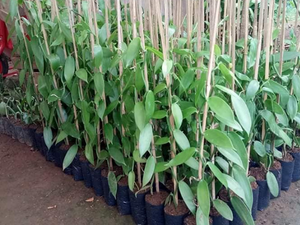
Stem cuttings are usually used to grow commercial vanilla. The following factors need to be considered to get better cuttings for a healthy vanilla plant:
Cuttings for vegetative propagation should be obtained from healthy, strong plants.
Selected plants must yield fruits that are at least three months old.
Selected plants need to be right after the harvest.
can be cut from any area of the vine.
The preferred cutting area is the section of the plant where the fruit is connected.
The amount of planting material available typically determines the length of the cut.
Short cuttings of 20 cm in length will blossom and fruit in 3 to 4 years.
Cuttings with a length of 90–100 cm are frequently prefered.
Vanilla Cuttings should be disinfected.
Young Vanilla plants should be disinfected afterwards to avoid any infections.
To allow planting, the three leaves at the base of the bot-cuttings must be removed with a knife or pruning pliers before disinfection.
It is critical to check the material to avoid disease transmission such as rotting, anthracnose, or mildew.
Bot-cutting disinfection is performed using a fungicide such as Benomyl at a concentration of 2 g/L as well as an adherent.
In a container big enough to submerge cuttings in bundles of ten to be impregnated, the preparation is combined with water.
Planting of Vanilla cuttings
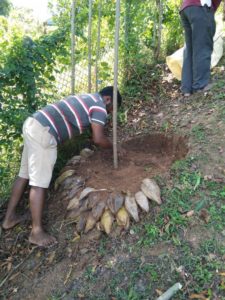
Cuttings are often planted in situ, but can be started in nursery beds if necessary. Because cuttings are succulent, they may be stored or transported for up to two weeks if necessary. Below are factors to consider before planting vanilla cuttings.
Cutting planting requires established shadows.
Wet organic debris grouped into blocks
Weed-free transit routes
cuttings with no branches higher than 1.7 m above ground.
Cuttings must be sterilised without the three base leaves.
Steps in the planting procedure
Prepare 20 cm deep holes on the ground at a 45-degree angle.
The piece with no leaves is introduced and gentle pressure is used to ensure that the cuts remain securely adhered.
The cuttings are then covered with organic materials.
The remainder of the cuttings are attached to the tutor.
It is advised that natural and biodegradable materials such as banana leaves, tree bark stripes, or creepers be used for this binding.
Cuttings are often planted 1-3 metres apart at the base of supporting trees or poles.
After-care
The vines must be trained so that they grow at a comfortable height for pollination and harvesting.
The vines are wrapped around the lower limbs of the supporting tree or over the trellis lattice to hang down.
Care must be taken not to injure or bruise the leaves, branches, or roots.
Typically, the top 7.5–10 cm of the vine is removed after 6–8 months.
Shade requirement
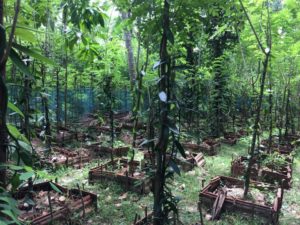
The shade requirement of vanilla land is closely related to plant development.
Shade must be consistent and maintain equilibrium throughout the year.
Shade helps to reduce moisture losses in the surrounding environment and organic matter is prevented during the dry months and protects the beans from low temperatures during the cold months.
Too many shadows cause stem weakening, while too few shadows cause burns during the dry season.
In either circumstance, the plant weakens and becomes vulnerable to disease assault.
Shadow handling during the year
Handling depends on humidity and sunlight conditions.
Dry seasons: There are frequently very sunny days here, and it is preferable to keep the humidity of the surroundings and organic matter high. In this situation, the shade should be at least 80% or equal to that provided by a mature mango tree.
Rainy Season: Excess humidity necessitates caution to prevent sun rays from burning the plants and the buildup of too much dampness in the surrounding environment. A 50% shade, similar to that produced by a mature blooming tree, is recommended.
Days are frequently gloomy during this season, and there is a constant and mild rain, which causes humidity accumulation. This condition reduces the likelihood of sunburn. It is suggested that a shadow of 20% be used.
Controlling of Shade-Pruning of climbing trees
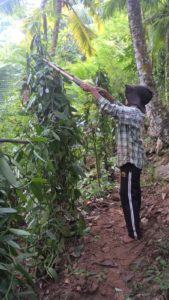
Shadow control in the forest begins with the trimming of the tutors (pichocos), but if a surplus of shadow persists, lower branches and natural brushes may be clipped.
If, on the other hand, regions of deficiency in higher shadows are discovered, it is vital to allow for the natural forage growth of tutors.
Shadows can be regulated in deforested areas by planting cocuites and pichoco trees.
Every year, this trimming procedure is repeated.
Common pests and diseases in vanilla cultivation

Vanilla is prone to a variety of fungal and viral diseases.
Fusarium, Sclerotium, Phytophthora, and Colletrotrichum species cause rots of the root, stem, leaf, bean, and shoot apex.
Unsuitable growth circumstances, such as overwatering, improper drainage, thick mulch, over pollination, and too much shade, promote the development of most diseases.
Spraying a Bordeaux mixture (1%) containing carbendazim (0.2%) and copper oxychloride (0.2%) can control fungal infections (0.2%).
Vanilla Plant Diseases and Controls
Vanilla is a crop that is produced in highly humid environments with rain-fed irrigation systems.
Due to the nature of its growth system, it is very susceptible to fungal and other illnesses from the surrounding tree canopy and biomass.
Clean maintenance, which should be practiced, will assist in minimizing costly losses.
Stagnant water will be a major issue and problem, and proper root system drainage is essential.
A well-executed preventative maintenance routine can help you avoid serious problems.
Sunburn of the leaves and foliage should be avoided with proper shade and biomass maintenance.
Control diseases through proper evaluation systems and documentation.
Reduce reoccurring issues and remove any competing organisms or insect pests before their population reaches enormous proportions. Secondary and continuous pest and disease management activities result in a hygienic farm.
The following are best practices to control diseases:
Plant nurseries with a high population of plants should be kept clean.
Suitable mulch should be used.
Before using compost or leaf mould, a thorough check should be conducted.
Excess water and water logging in irrigation systems should be checked since they might cause fungal diseases.
In dense cultivation systems, proper ventilation and air supply are essential.
Vanilla Fungal Diseases
Vanilla is sensitive to a wide range of fungal infections. The most prevalent fungal infections include rots of various plant sections such as beans, stems, shoot tips, leaves, and root systems. Fusarium, Sclerotium, Phytophthora, and Colletotrichum are the most common pathogens.
Below are the most common vanilla fungal diseases, along with their symptoms and control measures.
Anthracnose
Massae Calospora vanillae
Reasons for spreading: poor drainage, excessive soil moisture, extended wet weather, vine overcrowding, sick and dead leaves, beans, and aerial roots that fall to the ground.
Symptoms: The first signs of infection appear on fragile portions such as immature beans and the tips of aerial roots. The symptoms emerge on the beans as exceedingly minute pale red or amber-cultured pustules that grow up in tiny groups to produce discolored areas. They become black at the tip and in the center. Then they wilt and fall off after 2-3 days. Although the pustules occur on both sides of the leaves, the severity is greater on the top side. As the illness advances, the leaves begin to yellow and dry, eventually dying.
To prevent the illness from spreading further, proper phytosanitation (collection and burning of infected areas) is required.

Bean Rot
Pathogen: Phytophthora meadii.
Reasons for spreading: excessive shade in plantations, vine crowding, waterlogged conditions, constant rain, presence of Phytophthora inoculum.
Many vanilla gardens in Kerala, Southern India, have been affected by a serious rot outbreak, damaging vanilla beans (Suseela Bhai and Joseph Thomas, 2000). Diseases emerge from June to August, when the south-west monsoon rains are at their peak. Initially, rotting symptoms appear at the ends of the beans, then spread to the pedicel, terminating in the rotting of the entire bunch. Affected beans are soft and brown in color, with copious mycelial development. Later stages of the illness spread to the stem, leaves, aerial roots, and basal sections. The entire vine begins to deteriorate, and the plant perishes.
Controls include phytosanitation and spraying with a 1% Bordeaux mixture or 0.2 percent copper oxychloride.Akomin or Phytophos foliar spray containing 0.4 percent potassium phosphate (Akomin) is also effective in preventing disease transmission.

Leaf Rot
Fusarium oxysporum
Symptoms: It is usually found on mature or old leaves. Following infection, the leaf tip becomes somewhat yellowish to brown in color. Later, rotting occurs and progresses rearward, sometimes reaching the leaf’s center.
spraying with 0.2 percent Mancozeb (Indofil M-45) and 0.2 percent Carbendazim (Bavistin 50 W P), or a mixture of the two
Inflorescence rot
Colletotrichum sp. is the pathogen.
Symptoms: Flower buds are withering. The symptoms begin with the formation of brown spots on the flower stalks during the inflorescence’s elongation stage. This discoloration extends progressively to the flower buds, resulting in the shedding of the damaged flower buds.
Spraying flower buds with (0.2 percent) carbendazim was discovered to be an effective way to limit disease spread.

Rotting of the shoot tips
Colletotrichum gloeosporides, Fusarium oxysporum
Symptoms: Rotting of the main vine’s or its side branches’ shoots. The disease’s visible symptoms begin with rotting in the form of brown spots on the petiole and lower regions of the youngest leaf, which is barely unfolding. At this stage, the leaf is typically a funnel-shaped receptacle-like structure that may store rainwater or dew, creating an ideal environment for rotting. Within a few days, the rotting spreads to the afflicted leaves, and the shoot tip softens and becomes brown, eventually falling off. The infection is limited to the shoot tips.
Spray 0.2% carbendazim as a control.
Stem Rot
Symptoms: The symptoms are water-soaked sores that spread to both sides of the stem and have a brown colour. Later, elongated areas form on the stem, resulting in tissue degradation. The leaves become yellowish and eventually dry out in the advanced stages.
If the stem in the basal or central regions of the vines becomes diseased and shrivelled, the remaining distal portions wilt if a sufficient number of aerial roots are not established in the soil. In certain situations, the stem infection is followed by bean rotting.

Root rot
Fusarium batatis Wollenvar. vanillae is a type of Fusarium batatis.
Symptoms: The infection begins with browning at the root tips, which eventually degrade and result in the demise of the underground roots. The infection spreads progressively to the aerial roots as well. The damaged plants develop a large number of aerial roots, but the majority of them die before reaching the soil. Infection causes the stem and leaves to become flaccid, the stem to shrink, and the vines to droop. During dry months, especially in gardens with lots of sunshine, the symptoms become more noticeable. Due to a lack of proper water and mineral intake, the vines become less capable of withstanding infection during this period. Vanilla planifolia is determined to be the most vulnerable of the several kinds.
Controls: Soil soaking with 0.2 percent carbendazim or 0.2 percent copper oxychloride was used to suppress the illness. Under in vitro circumstances, the biocontrol agents Trichoderma viride, T. harzianum, and Pseudomonas fluorescens inhibited both the root rot pathogens Fusarium oxysporum and Sclerotium rolfsii. Trichoderma treatment at the base of vines has been shown to reduce inoculum buildup and root rot incidence.

Stem Blight
Pathogen: Phytophthora meadii.
Symptoms: Infection on the stem is frequently seen as brown-colored blighted areas that can reach several centimeters down the stem. The damaged area diminishes progressively, the leaves turn yellowish, and the vines dry up.
Controls include spraying with a 0.4 percent potassium phosphate solution or a 1% Bordeaux mixture.
VIRAL DISEASES IN VANILLA
Viruses are frequent in various locations where vanilla is farmed on a commercial basis. In 1987, Wisler et al. (1987) discovered a mosaic disease affecting vanilla in French Polynesia. The virus is sap transmissible and causes local lesions on Nicotiana tabacum infected leaves. The symptoms begin as mosaic or moderate mottling with chlorotic flecks or streaks on the leaves and, in rare cases, the stems. Typically, such mosaics are accompanied by stunting, sterility, and leaf deformities.
Cymbidium Mosaic Virus (CyMV)
In 1987, Wisler et al. (1987) discovered Cymbidium Mosaic Virus (CyMV) in vanilla cultivated in the South Pacific Islands. Infection with CyMV induces only moderate mottling or chlorotic streaks on the leaves. In most situations, vanilla plants infected with this virus show no symptoms.
Pearson and Pone (1988) discovered the virus in vanilla plants from the Kingdom of Tonga. Vanilla plants infected with ORSV are typically asymptomatic. On occasion, mild mottling can be seen on the leaves. The virus is spread by sap and stem cuttings used for multiplication.
Vanilla Necrosis Poty Virus
Vanilla necrosis is the most severe of all the viral illnesses impacting the crop, both in terms of symptoms and vine loss. Necrosis in V. planifolia has been found to be widespread in Tonga, Fiji, and Vanuatu (Pearson et al. 1990).
The disease manifests itself in young leaves as widespread chlorotic spots followed by leaf deformation. On older leaves and stems, necrotic lesions might be visible. Necrosis spreads in advanced stages, culminating in the death of afflicted vines.
Disease Management as a Whole
Fungal, viral, and bacterial infections damage vanilla plants, especially during the monsoon season or as a result of overwatering and inadequate ventilation. It is important to follow cultural, mechanical, biological, legal, and chemical procedures that can be viable as well as affordable when combined to produce high-quality, exportable vanilla beans.
Insects in Vanilla beans Plants
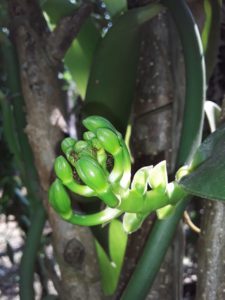
Vanilla insect pests include beetles and weevils that attack the flower. The caterpillars, snakes, and slugs that target the vulnerable sections of the shoot, flower buds, and immature fruit, and grasshoppers that attack the cutting shoot tips. Organic agriculture avoids the use of pesticides and instead relies on mechanical pest control tactics. Because such field conditions are extremely difficult to attain, the majority of these procedures are carried out in greenhouses.
Vanilla Plant Diseases and Controls
Vanilla is a crop that is produced in highly humid environments with rain-fed irrigation systems.
Due to the nature of its growth system, it is very susceptible to fungal and other illnesses from the surrounding tree canopy and biomass.
Clean maintenance, which should be practiced, will assist in minimizing costly losses to plants
Stagnant water will be a major issue and problem, and proper root system drainage is essential.
A well-executed preventative maintenance routine can help you avoid serious problems.
Sunburn of the leaves and foliage should be avoided with proper shade and biomass maintenance.
Control diseases through proper evaluation systems and documentation.
Reduce reoccurring issues and remove any competing organisms or insect pests before their population reaches enormous proportions. Secondary and continuous pest and disease management activities result in a hygienic farm.
The following are best practices to control diseases:
Plant nurseries with a high population of plants should be kept clean.
Suitable mulch should be used.
Before using compost or leaf mould, a thorough check should be conducted.
Excess water and water logging in irrigation systems should be checked since they might cause fungal diseases.
In dense cultivation systems, proper ventilation and air supply are essential.
Management of Diseases
- Prevent using too much organic manure, too much mulch, and too much water.
- Plant portions infected with disease should be cut and burned off.
- Spray the vines with 0.2 percent carbendazim, followed by 1 percent Bordeaux Mixture one week later. Repeat this process every month for a month.
- Transporting branch cuttings or planting materials from sick regions is not recommended.
- Viral-infected vines should be plucked and burned or deeply buried.
- Planting materials should not be taken from mosaic-affected vines.
- Do not contact a mosaic-affected plant with your hand or knife, and do not touch a healthy vine without first washing your hands.
- Plants should not be planted too close together or too densely.
- Excessive shadows should be avoided.
- Visit vanilla gardens on a regular basis to detect disease outbreaks and implement prompt management measures.
Vanilla plants Flowering and Pollination
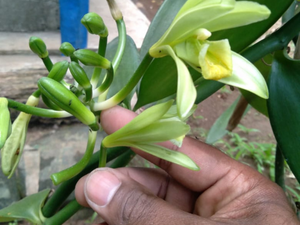
Vanilla often begins flowering in the second or third year after planting, depending on the size of the initial cuttings. Flowers achieve their peak productivity in 7 to 8 years.
The required number of flowers are hand-pollinated when they open.
Only the flowers on the bottom side of the raceme are pollinated in order for the fruits to hang perpendicularly and generate straight beans.
Flowers on the top side create crooked beans of lesser grade.
Typically, just one flower blooms in each inflorescence on a single day and is responsive for around eight hours.
The best time of the day to pollinate Vanilla Bean flowers
The flower blooms in the morning, closes in the afternoon, and never blooms again.
It will fall the next day if it is not pollinated. The best time for pollination is in the midmorning, from 11 a.m. to 12 p.m. Pollinating the Vanilla Flower (aos.org)
Number of flowers that need pollination. Pods per inflorescence
The number of inflorescences and flowers per vine, as well as the number that are pollinated and permitted to mature beans, is 8–10 flowers on 10–20 inflorescences. Allow 4–8 beans to mature per size.
Pollination must be done in the mornings and must be repeated every 1 or 2 months until the required number of fruits has set.
When the required number of fruits have formed, the remaining buds are eliminated by trimming the tip of the inflorescence.
During development, damaged and deformed capsules are eliminated.
The number of beans produced per vine varies greatly, but it is usually between 30 and 150.
Hand pollination of vanilla flowers
Why do vanilla flowers need hand pollination?
The vanilla flower is self-fertile, but it can’t pollinate itself without the help of a third party to either transport pollen from the anther to the stigma or remove the flap or rostellum, then push the anther against the stigma.
Hand-pollination is used for the majority of the commercial vanilla crop, and it is estimated that this accounts for half of the overall labor cost of vanilla production.
The following are the simple six steps to pollinating vanilla bean flowers.
Look within the column with the hand lens for the pollinia, a pollen-covered cluster connected to the ceiling.
Insert the toothpick into the pollinia column and gently pull the pollinia straight out.
To release the beautiful yellow pollen, detach the pollinia from the spring-like anther and gently compress it between your thumb and fingertip.
Use a toothpick with a slightly moistened tip to catch pollen.
Turn the toothpick around and delicately lift the rostellum, which covers the stamens, with the free end. Turn the toothpick around while holding the rostellum back with your fingertips.
Apply the pollen to the spherical stigma hole by carefully twisting the toothpick.
The development of vanilla fruit or beans after pollination
If pollination was successful, the drooping flower should remain connected to the plant and show symptoms of pod formation after a week or two.
When pollination fertilizes it, the ovary of the flower grows enlarged and transforms into a fruit. The ovules inside the ovary of the flower harden and form the seeds inside the fruit.
Features of the green vanilla beans
The seed pod grows over a period of 8 to 9 months. A healthy vine may yield up to 100 vanilla pods each year.
.The pod is still green, fat, and young. At this point, there is no scent.
The capsule, sometimes known as a bean in the trade, is pendulous, narrowly cylindrical, and obscurely three-angled, measuring 10–25 cm long and 5–15 mm in diameter.
When mature, it contains myriads of extremely minute globose seeds, around 0.3 mm in diameter, discharged by the capsule splitting lengthwise.
Capsules are picked before they are fully mature in commercial cultivation.
To prevent theft, it is common in certain countries for owners to prick distinctive symbols on the green pods of the vines.
Harvest Green Vanilla Beans
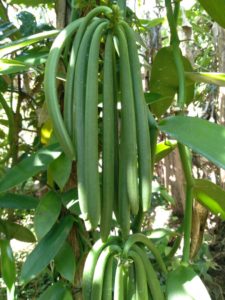
It has been considered that a minimum waiting period for harvesting should be nine months after pollination.
Harvesting entails cutting the beans and packing them in bags. To avoid physical harm to the beans, cutting is done by hand with no equipment or utensils.
When is the best time to harvest beans
Vanilla fruits need to be gathered when they are fully mature but before they are too ripe. The reasons are:
Fruits do not acquire the necessary full-bodied aroma and color during processing.
more prone to fungal infection
The fruits split and lose part of their scent.
Vanilla Harvesting indicators:
The below indices help to decide when to harvest vanilla beans from the plant.
The thickest part of the fruit (the “flower end”) turns light yellow.
The overall color of the pod shifts from dark green to light green.
The fruits’ luster fades, and they turn slightly bland.
There are two separate lines that run from one end of the fruit to the other end.
Well-ripened beans easily separate from the bunch by pulling them in the opposite direction.
It is important that old stems and weak branches are trimmed after fruiting. The tree supports or shade should be cut to allow around 50% of the sunshine and to induce branches at the proper height for training the vines
Curing of Vanilla Beans
One of the most important parts of vanilla production is the vanilla curing process. This post-harvest processing and curing is very critical for vanilla quality and vanillin content. So it is important to follow the below process of curing vanilla beans.
Curing green vanilla beans does not have any market value unless you follow curing steps
When to start curing after harvest green beans
After harvest is the best time to begin curing vanilla. The processing should begin as soon as possible, ideally within a week following the harvest.
What is curing?
Vanilla curing is a careful procedure that includes fermentation, sweating, and gradual drying. The primary component responsible for the aroma is “vanillin.”
Vanilla beans must be properly cured in order to get the appropriate aroma and flavor from your vanilla beans. It is necessary to assist both the vanillin development and the gradual drying of the bean in order to preserve it while processing vanilla beans.
During the last few days of ripening, the vanilla creates a sugar called glucovanillin. Glucovanillin will be broken down into glucose and vanillin during the fermentation process.
Stages in vanilla curing
Grading & Sorting:
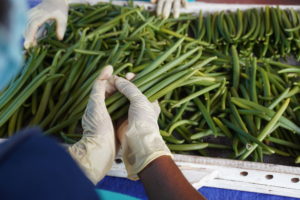
Sorting and grading of green vanilla beans is important in the curing process. Size and appearance are given top priority in the sorting process, and they are critical to the quality of vanillin present and the aroma. The beans are classified as A, B, C, and D in the green stage based on the length of the beans.
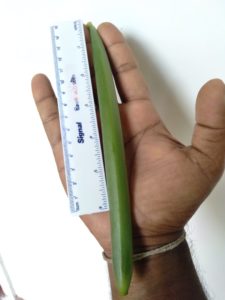
A grade-length of more than 15 cm
10-15 cms in B grade
C Grade-less than 10cm
Cut, split, bruised or damaged green beans.
Cleaning:
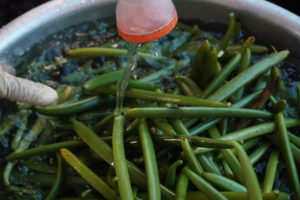
It is important to wash and clean the graded beans well before curing. This helps to clean any residue chemicals or Bordeaux stains from the beans. The concentrated tamarind water, or sour milk, is also used to clean green beans.
Four main phases in curing vanilla beans
1. Phase of death or wilting:
What happens during the killing process?
This halts further vegetative development in the fresh bean and activates the enzymatic activities that provide aroma and flavor. The development of a brown color in the bean indicates that it has been killed.
The killing time of sorted and graded beans varies because it controls the stopping of vegetative development and chemical changes in the beans, and it is a critical phase in the entire process.
Process of killing green vanilla beans
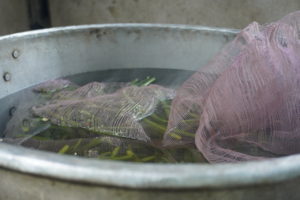
Dip the beans in regulated hot water with a bath temperature of 65 C maintained for a specific time frame depending on the grade.
Typically, a maximum duration of 4 minutes is provided for Grade A beans, with decreasing times for the rest of the beans as follows: 3 minutes for Grade B, 2 minutes for Grade C, and 1.5 minutes for Grade D.
Once the beans reach the temperature of the bath, they must be kept heated for a period of time to complete the conversion, so the sweating process becomes crucial.
2) Sweating Phase:
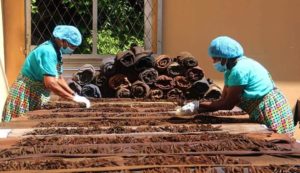
What happens during the sweating process?
This entails increasing the temperature of the dead beans in order to stimulate the appropriate enzymatic processes and causing a first, relatively quick drying in order to prevent undesirable fermentations.
During this process, the beans grow a darker brown color and become fairly supple, as well as develop a vanilla aroma.
process of sweating vanilla beans
Transfer killed beans to a box covered with woolen blankets or insulation to keep the temperature at 48–50C.
Keep the beans for a period of 24–40 hours.
The entire beans transform into a supple brown color with a vanilla aroma.
If the procedure is not completed, the killing must be repeated until a swollen, brown, and plump vanilla bean is obtained.
Continue sun-drying for days. The best time for sun drying is from 11 a.m. to 2 p.m.
When the beans’ temperatures reach 50 degrees Celsius, they are covered in woolen blankets and preserved in wooden boxes.
3) Phase of drying:
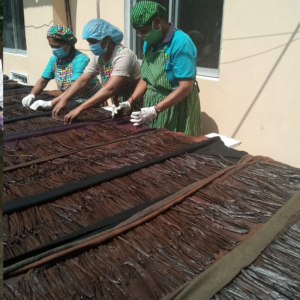
What happens during the drying process?
The gradual drying at room temperature, generally in the shade, until the beans are one-third of their original weight. Normally, sun drying for a week is done. There are two types of drying that aid in reducing the moisture content of the beans to less than 25%.
The process of drying vanilla beans
The beans are spread on wooden slats, shelves, or clean blankets on a flat surface from 12 p.m. to 3 p.m.
Leave the beans until they reach a uniform temperature of 50-55 C.
Then they are wrapped in blankets and relocated back to the bundles to continue sweating.
It is best to keep it in a hot, dry environment to maintain a high heat and dry atmosphere for consistent moisture loss.
They are maintained in sweating boxes or enclosures for the entire night and repeated to get a consistent texture.
At the end of the process, the beans have lost half their weight and have turned a gleaming dark brown colour with a deep aroma.
By massaging the beans with your fingers, you help to increase their elasticity and texture. Sweating and sun drying time for grades B, C, and D beans is less than one week when compared to A-grade beans.
Slow drying and conditioning phase:
The final stage of curing is “conditioning.” The beans are held in tight boxes for three months or longer to develop the perfect aroma and flavor.
The two most significant traditional methods for curing vanilla beans are those used in Mexico and the Indian Ocean islands that produce “Bourbon” vanilla.
Slow curing is a long process that involves seasoning the beans in a controlled air temperature and humidity system.
Process of slow-dried vanilla beans (conditioning of vanilla beans)
Beans are often stored in trays and racks with two or three layers to provide uniform drying exposure.
The temperature in these rooms is kept at 35°C, and the relative humidity is kept at 65–70%.
The drying time varies for each grade according to quality.
It usually takes roughly 35 days for A-grade beans, 20–25 days for B-grade beans, 3–10 days for C-grade beans, and 2–8 days for D-grade beans.
After gradual curing, the beans have a homogeneous texture, shrink to have longitudinal lines, change to a glossy, brownish chocolate color, and become very soft.
They are pleasant to the touch and may be wrapped around your finger. The moisture content is between 30 and 35 percent.
Final condition stage beans are bundled and stored in dry wooden or metal boxes for around 30-60 days. The tied beans are wrapped in oily paper to aid in seasonal conditioning.
It is preferable to have it in a warm environment of 30–35 C. This helps to get the moisture to approximately 25%.
To minimise additional moisture loss and mould growth, store them in airtight containers.
Some beans generally produce crystals in the shape of vanilla sugar crystals on the surface, which is a sign of high-grade beans.
Quality Control Process in Vanilla Beans
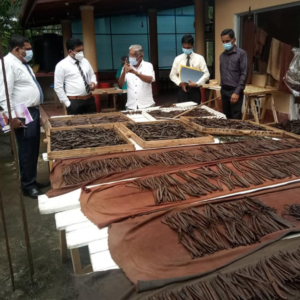
Main Factors Affecting Vanilla Bean Quality
Harvesting should not be delayed at any cost.
Care should be given while handling large amounts of beans since overloading leads to bruising the beans.
Selecting the properly matured beans for harvest
The temperature of the killing should not surpass 65°C, and time is equally crucial.
Sweating over an extended period of time will cause the beans to deteriorate.
Fungal infections on vanilla curing should be addressed as soon as they appear.
Infected beans should be killed again in 65*C water for a few seconds, and then the drying procedure should be repeated until the mould is gone.
The quality of the vanilla beans should be evaluated at each stage, including a cross-check on the weight of the beans as they travel through the stages. This will be crucial in selecting the proper mix and practicing.
Identify the best-cured vanilla beans.
How to identify the best-cured vanilla beans.
capable of wrapping around your finger
Color ranging from dark brown to black
strong aroma and flavor.
Moisture content of 30-40%
Long, supple, pliable, fleshy beans
A slightly oily appearance
Clear beans without scars.
characteristics of low quality vanilla beans
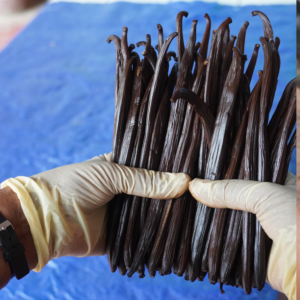
Beans are reddish-brown to dark brown.
Dry, hard, thin beans
Poor aroma
10% moisture content
Comparison of the curing methods used in different countries
It is interesting to know how the curing process differs in vanilla-producing countries.
The Curing of Bourbon in Madagascar and Other Indian Ocean Countries
Bourbon vanilla is a product from the former French colonies in the Indian Ocean that uses a curing process invented on the island of Reunion, previously known as Bourbon. Madagascar dominates the production of Bourbon-type vanilla compared to other vanilla-producing countries in the Indian Ocean (India, Mauritius, Seychelles, Reunion, Mayotte, Sri Lanka).
The Bourbon curing procedure differs from that used in Mexico. The ‘killing’ is accomplished by scorching the beans in hot water, resulting in fewer sweating. The Bourbon product is generally frosted and has a higher moisture level than Mexican vanilla grades. Most of the vanilla curing in Mexico is done by specialized corporations rather than vanilla farms or small growers.
In Sri Lanka Vanilla cultivation and processing is in higher elevations where curing process is similar to Madagascar.
The curing procedure for Bourbon vanilla takes 5 to 8 months. Madagascar’s major harvesting season lasts from June until early October.
There are some differences in the curing processes used on the various vanilla-producing islands. Madagascar growers use the below steps in curing their green beans.
Killing Process When the beans arrive at the curing facility, they are sorted according to maturity, size, and split and unsplit kinds.
Bean batches weighing 25 to 30 kg are put into openwork cylindrical baskets.
Green beans are immersed in vessels filled with hot water heated to 63–65 °C over a wood fire.
The smaller, split beans are immersed for less than 2 minutes, while the top three quality batches of beans are soaked for 2 to 3 minutes.
The heated beans are quickly drained and wrapped in a black cotton cloth.
Placed in a fabric-lined sweating box
The beans are removed after 24 hours and examined to distinguish those that have not been fully killed.
Sun Drying
The dead beans are spread out on black cloths sitting on bamboo slatted platforms about 70 cm above the ground.
After one hour of direct sun exposure, the edges of the fabric are folded over the beans to retain heat.
The cloth-wrapped beans are then left in the sun for another two hours before being rolled up and brought inside.
This process is continued for 6 to 8 days, or until the beans are very supple.
Slow Drying/Gradual Drying
The next stage is gradual drying in the shade for 2 to 3 months.
In a well-ventilated environment, the beans are spread on racks fixed on supports with 12 cm of space.
During this drying process, the beans are sorted on a regular basis.
Beans dried to the required moisture content are removed immediately for conditioning.
Due to inclement weather, some Bourbon-producing locations used indoor drying.They used an oven set at 45 to 50 °C.
Vanilla Conditioning
Beans are sorted again and straightened by dragging them between the fingers.
Straightening fingers aids in the spread of oil that seeps during the curing process.
The beans are then wrapped into bundles of around fifty using black twine.
The bundles are wrapped in waxed paper and placed in metal conditioning boxes lined with waxed paper.
Conditioning lasts at least three months, during which time the beans are examined on a regular basis.
Mouldy beans are removed for treatment.
The beans are graded and packed for transportation at the end of the conditioning stage.
The Vanilla Curing process in Puerto Rico
In the 1940s, a variation on the traditional Bourbon curing procedure was developed in Puerto Rico.
separated into split and unsplit varieties before being destroyed.
The beans are cleansed with a moist towel before being killed.
Scalding includes three 10-second immersions in an 80-°C water bath at 30-second intervals.
The beans are covered in a blanket and placed in a sweat box once they have been drained.
Killing is followed by daily two-hour sunnings and nocturnal sweatings for approximately seven days, or until the beans become supple.
The following stage of indoor air-drying is repeated until the beans have shrunk to one-third of their initial weight.
The beans are packaged and conditioned in tin boxes until they dry to one-quarter of their original weight.
Unlike Bourbon vanilla from the Indian Ocean, Puerto Rican vanilla scalded at 80°C seldom frosts.
When the weather does not permit sunbathing, the beans are sweated in a closed oven at 45 °C with a pan of water.
Curing methods in Mexico.
The two primary traditional processes of curing used in Mexico are sun-wilting and oven-wilting. Sun-wilting is the earliest known curing procedure in Mexico, whereas oven-wilting was established around 1850. Both processes are still frequently used by the specialised curing enterprises that handle the large majority of the vanilla harvest in Mexico. In Mexico, the harvesting season lasts from November to January, and curing by either process takes around five to six months until the product is ready for sale.
Sun-Wilting
On arrival at the curing house, the fresh beans may be set aside in a store for a few days until required, and during this time, the beans start to wrinkle.
The fresh beans first have their peduncles removed and are then sorted according to their degree of maturity, size, unsplit and split types.
Beans, which are already beginning to darken, are removed, wiped with castor oil, and cured separately.
Killing
After sorting, the beans are killed by exposing them to the sun for around five hours.
The fresh beans are laid out on black mats on a cement patio or wooden racks.
When beans are too hot to hold by hand in the afternoon, they are then covered by the blanket’s borders.
The thick ends of the beans are positioned towards the middle of the blanket and wrapped up in the mid-to-late afternoon, before the beans have begun to cool.
The blanket rolls are immediately brought indoors and placed in blanket-lined, airtight mahogany boxes to “sweat” for the first time.
To prevent heat loss, blankets and matting are put over the sweating boxes.
The beans are collected and examined after 12 to 24 hours.
The majority of the beans will have begun to turn a dark-brown colour, signifying a successful ‘killing.’
Beans that have preserved their natural green colour or have an inconsistent tint are separated and oven-wilted.
Sunning and Sweating
Sunning is the process of spreading the beans on blankets and exposing them to the sun for two to three hours during the warmest portion of the day when weather conditions are favourable.
Unless sweating is required, the beans are held indoors on wooden racks in a well-ventilated room for the remainder of the day.
The first stage entails a rather quick drying in which the beans are given sunnings almost every day and multiple overnight sweatings until they become pliable.
This takes around five to six days. At this point, a preliminary sorting into lots corresponding to the various vanilla grades is frequently performed.
This is followed by additional sunning and less frequent sweating.
In practice, “sunnings” are rarely performed every day during this second phase; overly quick drying is seen to be damaging to the quality of final vanilla beans.
Most of the beans become very pliable and acquire qualities similar to those of the final product 20 to 30 days after dying.
The total number of sweatings during the sunning and sweating procedure could range between four and eight.
The beans, which require a high number of sunnings and sweatings, yield a low-quality vanilla product.
Slow drying
Indoors, very slow drying takes about a month, and further sorting into classes is normally done during this period.
The beans are examined on a regular basis, and those that have reached the required level of dryness are promptly taken off the racks for “conditioning.”
The overall sweating and drying operation may take up to 8 weeks from the time of “killing,” according to the prevailing weather conditions.
Small and split beans are frequently ready for conditioning before large, perfect, flawless beans.
Conditioning
Beans taken for conditioning are sorted again and straightened by dragging them between the fingers.
This technique is also beneficial in that it distributes the oil that seeps during the curing process and gives the beans their unique sheen.
The beans are then wrapped into bundles of around fifty using black twine.
The bundles are wrapped in waxed paper and placed in waxed paper-lined metal conditioning boxes.
Conditioning takes at least 3 months, during which time the beans are examined on a regular basis.
Mouldy beans are removed for treatment, and those that do not produce the required aroma may be subjected to sunnings and sweatings again.
At the completion of the conditioning phase, the beans are graded and packed for export.
The process of oven-wilting in Mexico
A specially designed brick or cement room known as a calorifico, which functions as an autoclave, is used in this technique.
The Structure of the Oven
The chamber is roughly 4 x 4 x 4 metres in size and has a wood-fired heater that is fueled from the outside. It includes a tiny access door and wooden racks installed along the walls.
How to wilt beans in the oven?
The beans to be killed are separated into heaps of up to 1000.
Beans are folded up in a blanket, which is then covered with matting to make a malleta or case.
The malletas are dampened with water and placed on the oven shelf. To maintain a high humidity level, water is poured onto the solid floor, the door is closed, and the heating fire is started.
In about 12 hours, the temperature inside the calorifico reaches 60 °C.
After 16 hours, a temperature of 70 °C is reached and maintained for another 8 hours.
After 36 hours in the calorifico, the malletas are removed. If the temperature cannot be raised above 65 degrees Celsius, the autoclaving time is extended to 48 hours.
When the malletas are removed from the calorifico, the matting is swiftly removed and the blanket-wrapped beans are placed in sweating boxes.
The beans are removed and examined after 24 hours.
Following that, the dead beans are subjected to a series of sunnings and sweatings, as described above under “Sun-wilting.”
If the weather is cloudy, the dead beans are held indoors on racks in a well-ventilated area until sunbathing is allowed.
If the weather does not improve in three days, the batch is reprocessed using the calorifico and sweating box.
Tahiti Vanilla Curing Process
The beans are not killed artificially.They are collected when they reach maturity. This is characterised by the browning of the bean’s tip. Curing is done by specialised companies that use a process that is comparable to the Mexican curing method.
The major harvest occurs in February and March, with drying being completed in July and August.
The green vanilla beans arrange them in stacks that are flipped daily.
Beans that are completely brown, marking the end of vegetative life, are removed for sweating and drying.
The ‘dead’ beans are stretched out on blankets sitting on high wooden racks for three to four hours in the sun.
The heated beans are then wrapped in a blanket and placed in a sweat box for the night.
This procedure is repeated for 15-20 days, with fewer and fewer nighttime sweatings.
Then the beans are laid out in 10 cm layers to dry in the breeze.
When the beans are dried enough, they are taken from the racks and packed into huge containers.
The majority of beans are sorted and sold quickly after drying is done, with no extended “conditioning” time.
If the beans are preserved for an extended period of time before sale, they are kept in tins.
About Vanillin
Natural vanillin is derived from the seed pods of Vanilla planifolia, a vining orchid native to Mexico that is currently grown in tropical locations all over the world. At the moment, Madagascar is the world’s greatest producer of natural vanillin.
The green seed pods contain vanillin in the form of its-d-glucoside when harvested; the green pods do not have the flavor or odor of vanilla.
How does vanillin develop in the curing process?
After being picked, their flavor is formed through a months-long curing process, the details of which differ across vanilla-producing countries, but in general, it goes as follows:
To begin with, the seed pods are blanched in hot water to halt the activities of live plant tissues.
The pods are then alternately sunned and sweated for 1–2 weeks: during the day, they are stretched out in the sun, and at night, they are covered in fabric and stored in airtight boxes to sweat.
The pods turn dark brown during this process, and enzymes in the pod release vanillin as a free molecule.
Finally, the pods are dried and stored for many months, allowing their tastes to develop further.
Several methods for curing vanilla in days rather than months have been described, but they have not been widely developed in the natural vanilla industry, which focuses on producing a premium product using established methods rather than on innovations that may alter the product’s flavor profile.
The best conditions for storing processed vanilla beans
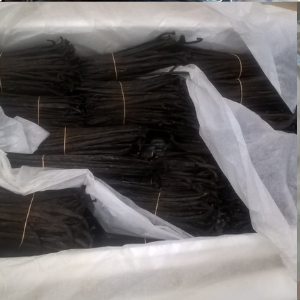
The storage of vanilla beans following the gradual conditioning procedure is also crucial for quality. The ultimate scent will be influenced by how the vanilla beans are kept and maintained. Similarly, handling at various stages of vanilla curing necessitates the use of specialized trays and material handling equipment that is appropriate for the process’s quality.
Suitable phytosanitary precautions should be taken to prevent pests and diseases in storage. Those are moulds, fungus, hard fungus, scales, and mite infections.
The storage space should be cleaned and well-kept, with suitable aeration and humidity controls.
All wrapping materials should be sterile.
The contaminated beans should be separated from the rest of the portion.
Excessive drying will cause moisture loss and make the beans more brittle as they mature.
Most beans are vacuum-packed to eliminate air-related difficulties and to preserve the beans intact for a longer period of time.
Appropriate vacuum packing methods and poly liners should be utilized for this purpose.
About Vanillin
Natural vanillin is derived from the seed pods of Vanilla planifolia, a vining orchid native to Mexico that is currently grown in tropical locations all over the world. At the moment, Madagascar is the world’s greatest producer of natural vanillin.
The green seed pods contain vanillin in the form of its-d-glucoside when harvested; the green pods do not have the flavour or odour of vanilla.
How does vanillin develop in the curing process?
After being picked, their flavour is formed through a months-long curing process, the details of which differ across vanilla-producing countries, but in general, it goes as follows:
To begin with, the seed pods are blanched in hot water to halt the activities of live plant tissues.
The pods are then alternately sunned and sweated for 1–2 weeks: during the day, they are stretched out in the sun, and at night, they are covered in fabric and stored in airtight boxes to sweat.
The pods turn dark brown during this process, and enzymes in the pod release vanillin as a free molecule.
Finally, the pods are dried and stored for many months, allowing their tastes to develop further.
Several methods for curing vanilla in days rather than months have been described, but they have not been widely developed in the natural vanilla industry, which focuses on producing a premium product using established methods rather than on innovations that may alter the product’s flavour profile.
The Chemistry of Vanillin
Vanillin is a chemical molecule with the formula C8H8O3. It is a kind of phenolic aldehyde. Aldehyde, hydroxyl, and ether are some of its functional groups. It is the major component of vanilla bean extract. As a flavouring ingredient in foods, drinks, and medications, synthetic vanillin is currently utilised more frequently than genuine vanilla extract.
The food business uses both vanillin and ethylvanillin; ethylvanillin is more costly but has a greater flavour. It varies from vanillin in that it has an ethoxy group (OCH2CH3) rather than a methoxy group (OCH3).
In addition to vanillin, natural vanilla extract contains hundreds of distinct chemicals. Artificial vanilla flavouring is frequently a solution of pure vanillin, which is typically synthetic in nature. Because real vanilla extract is scarce and expensive, synthetic synthesis of its primary component has long been of interest. The first commercially viable vanillin synthesis began with the more widely available natural component eugenol (4-allyl-2-methoxyphenol). Nowadays, artificial vanillin is manufactured from either guaiacol or lignin.
Acknowledgements and References
For assistance in compiling this long article about vanilla beans, I am grateful to the following websites:
Flower with money power. The Hindu. 10 May 2004.
Mushet, Cindy; Table, Sur La (21 October 2008). The Art and Soul of Baking. Andrews McMeel Publishing. ISBN 9780740773341. Archived from the original on 8 December 2017
Tahitian Vanilla Originated in Maya Forests, Says UC Riverside Botanist”. University of California at Riverside, Newsroom. 21 August 2008. Archived from the original on 17 May 2017. Retrieved 28 June 2017
USDA, NRCS (n.d.). “Vanilla pompona“. The PLANTS Database (plants.usda.gov). Greensboro, North Carolina: National Plant Data Team. Archived from the original on 9 October 2008. Retrieved 24 July 2008.
Margraf, Marelke (July 2015). “Comparison of Compounds in Bourbon Vanilla Extract and Vanilla Flavour”. Chromatography Online
Bomgardner, M.M. (2016). “The problem with vanilla”. Chemical and Engineering News. 94 (36): 38–42. doi:10.1021/cen-09436-cover. Archived from the original on 10 September 2017.
Gobley, N.-T. (1858). “Recherches sur le principe odorant de la vanilla” [Research on the fragrant substance of vanilla]. Journal de Pharmacie et de Chimie. Series 3. 34: 401–405. Archived from the original on 3 June 2016.
Anilkumar, A. S. (February 2004). “Vanilla cultivation: A profitable agri-based enterprise” (PDF). Kerala Calling: 26–30. Archived from the original (PDF) on 28 February 2013
Berninger, F., Salas, E., 2003. “Biomass dynamics of Erythrina lanceolata as influenced by shoot-pruning intensity in Costa Rica.” Agro-forestry Systems, 57:19–28.
Davis, Elmo W. (1983). “Experiences with growing vanilla (Vanilla planifolia)”. Acta Horticulturae. 132 (132): 23–9. doi:10.17660/ActaHortic.1983.
132.2
Elizabeth, K. G. (2002). “Vanilla: an orchid spice”. Indian Journal of Arecanut Spices and Medicinal Plants. 4 (2): 96–8.
George, P. S.; Ravishankar, G. A. (1997). “In vitro multiplication of Vanilla planifolia using axillary bud explants”. Plant Cell Reports. 16 (7): 490–494. doi:10.1007/BF01092772. PMID 30727638. S2CID 25158520
Kononowicz, H.; Janick, J. (1984). “In vitro propagation of Vanilla planifolia”. HortScience. 19 (1): 58–9.
Giridhar P, Ravishankar GA (2004). “Efficient micropropagation of Vanilla planifolia Andr. under influence of thidiazuron, zeatin and coconut milk”. Indian Journal of Biotechnology. 3 (1): 113–118. Archived from the original on 6 May 2014.
About Vanilla – Vanilla imitations”. Cook Flavoring Company. 2011. Archived from the original on 30 April 2009. Retrieved 22 June 2011
“IMPORT ALERT IA2807: “DETENTION WITHOUT PHYSICAL EXAMINATION OF COUMARIN IN VANILLA PRODUCTS (EXTRACTS – FLAVORINGS – IMITATIONS)””. U.S. Food and Drug Administration Office of Regulatory Affairs. January 1998. Archived from the original on 3 June 2009. Retrieved 21 December 2007.
Burdock GA (2007). “Safety assessment of castoreum extract as a food ingredient”. Int. J. Toxicol. 26 (1): 51–55. doi:10.1080/10915810601120145. PMID 17365147. S2CID 39977652.
Kennedy, C Rose (2015). “What’s in a flavor? Vanillin dreams”. The Flavor Rundown: Natural vs. Artificial Flavors. Boston, MA: Harvard University, Graduate School of Arts and Sciences. Archived from the original on 2 December 2016
Burdock, George A., Fenaroli’s Handbook of Flavor Ingredients Archived 6 May 2016 at the Wayback Machine. CRC Press, 2005. p. 277.
S. Van Dyka, P. Holforda, P. Subedib, K. Walshb, M. Williamsa, W.B. McGlassona (2014). “Determining the harvest maturity of vanilla beans”. Scientia Horticulturae. 168: 249–257. doi:10.1016/j.scienta.2014.02.
002.
Havkin-Frenkel D, French JC, Graft NM (2004). “Interrelation of curing and botany in vanilla (vanilla planifolia) bean”. Acta Horticulturae. 629 (629): 93–102. doi:10.17660/ActaHortic.2004.
629.12. S2CID 90867600.
Havkin-Frenkel, D.; French, J. C.; Pak, F. E.; Frenkel, C. (2003). “Botany and curing of vanilla”. Journal of Aromatic Medicinal Plants
Frenkel, Chaim; Ranadive, Arvind S.; Vázquez, Javier Tochihuitl; Havkin-Frenkel, Daphna (2010). “Curing of Vanilla”. In Havkin-Frenkel, Daphna; Belanger, Faith (eds.). Handbook of Vanilla Science and Technology. John Wiley & Sons. pp. 79–106 [87]. ISBN 978-1-4443-2937-7. Archived from the original on 25 April 2016.
Arana, Francisca E. (October 1944). “Vanilla curing and its chemistry”. Bulletin (42): 1–17. Archived from the original on 27 April 2016.
Methods of dehydrating and curing vanilla fruit[permanent dead link] US Patent 2,621,127
Havkin-Frenkel, Daphna; Belanger, Faith C. (2011). Handbook of Vanilla Science and Technology. Chichester, UK: Wiley-Blackwell. pp. 142–145. ISBN 978-1-4051-9325-2.
“Vanilla”. Vanilla Review. Archived from the original on 8 March 2012. Retrieved 15 January 2012.
Nielsen Jr., Chat (1985). The Story of Vanilla. Chicago: Nielsen-Massey Vanillas.
“Vanilla”. Spices Board of India. Ministry of Commerce & Industry, Government of India. Archived from the original on 27 October 2011. Retrieved 16 January 2012.
K. Gassenheimer; E. Binggeli (2008). Imre Blank; Matthias Wüst; Chahan Yeretzian (eds.). “Vanilla Bean Quality – A Flavour Industry View” in Expression of Multidisciplinary Flavour Science: Proceedings of the 12th Weurman Symposium (Interlaken, Switzerland 2008). Wädensil, Switzerland: Zürich University of Applied Sciences. pp. 203–206. ISBN 978-3-905745-19-1.
“LFIE Vanilla Products”. Lopat Frederic Import Export. Archived from the original on 8 March 2012. Retrieved 16 January 2012.
“Vanilla Bourbon”. SA. VA. Import – Export. Retrieved 16 January 2012
“Vanilla Products”. Gascar Trading Company.
“Vanilla Bean Products”. Vanexco. Archived from the original on 20 January 2013. Retrieved 16 January 2012.
“Vanilla production in 2018; Production/Crops/Production Quantity from Elements”. UN Food and Agriculture Organization, Statistics Division (FAOSTAT). 2018. Retrieved 6 May 2020.
“Revival of Indonesian Vanilla Production amid Production Decrease in Madagascar”. Tridge. 7 January 2020. Retrieved 25 February 2020.[permanent dead link]
“Transforming the vanilla supply chain in Madagascar”. Medium. 17 September 2017. Retrieved 13 March 2018
Kacungira, Nancy (19 August 2018). “Fighting the vanilla thieves of Madagascar”. BBC. Retrieved 19 August 2018.
The U.S. Food and Drug Administration requires at least 12.5% of pure vanilla (ground pods or oleoresin) in the mixture Archived 29 September 2006 at the Wayback Machine
The U.S. Food and Drug Administration requires at least 35% vol. of alcohol and 13.35 ounces of pod per gallon Archived 1 May 2010 at the Wayback Machine
^ Rain, Patricia (2004). Vanilla: The Cultural History of the World’s Most Popular Flavor and Fragrance. Tarcher. ISBN 9781585423637.
Le Cordon Bleu (2009). Le Cordon Bleu Cuisine Foundations. Cengage learning. p. 213. ISBN 978-1-4354-8137-4.
Parthasarathy, V. A.; Chempakam, Bhageerathy; Zachariah, T. John (2008). Chemistry of Spices. CABI. p. 2. ISBN 978-1-84593-405-7.
“Vanilla remains top ice cream flavor with Americans”. International Dairy Foods Association, Washington, DC. 23 July 2013. Archived from the original on 16 September 2016. Retrieved 29 August 2016.
Rosengarten, Frederic (1973). The Book of Spices. Pyramid Books. ISBN 978-0-515-03220-8.
“Pure versus Imitation Vanilla Extract”. Cooks Illustrated. 1 March 2009. Archived from the original on 5 May 2013. Retrieved 30 April 2013.
“Tasting lab: Vanilla Ice Cream”. Cooks Illustrated. 1 May 2010. Archived from the original on 10 May 2013. Retrieved 30 April 2013.
“Vanilla Extract”. 1 March 2009. Archived from the original on 27 June 2012. Retrieved 19 June 2012.
Jaucourt, Louis (1765). “Vanilla”. Encyclopédie Ou Dictionnaire Raisonné des Sciences, des Arts et des Métiers. hdl:2027/spo.did2222.0000.830.
“Vanilla planifolia Andrews – Plants of the World Online – Kew Science”. powo.science.kew.org. Archived from the original on 22 November 2017.
“Vanilla”. Plants for a Future. Archived from the original on 1 December 2017.
6 Benefits of Vanilla Extract and Vanilla Beans (healthline.com)
